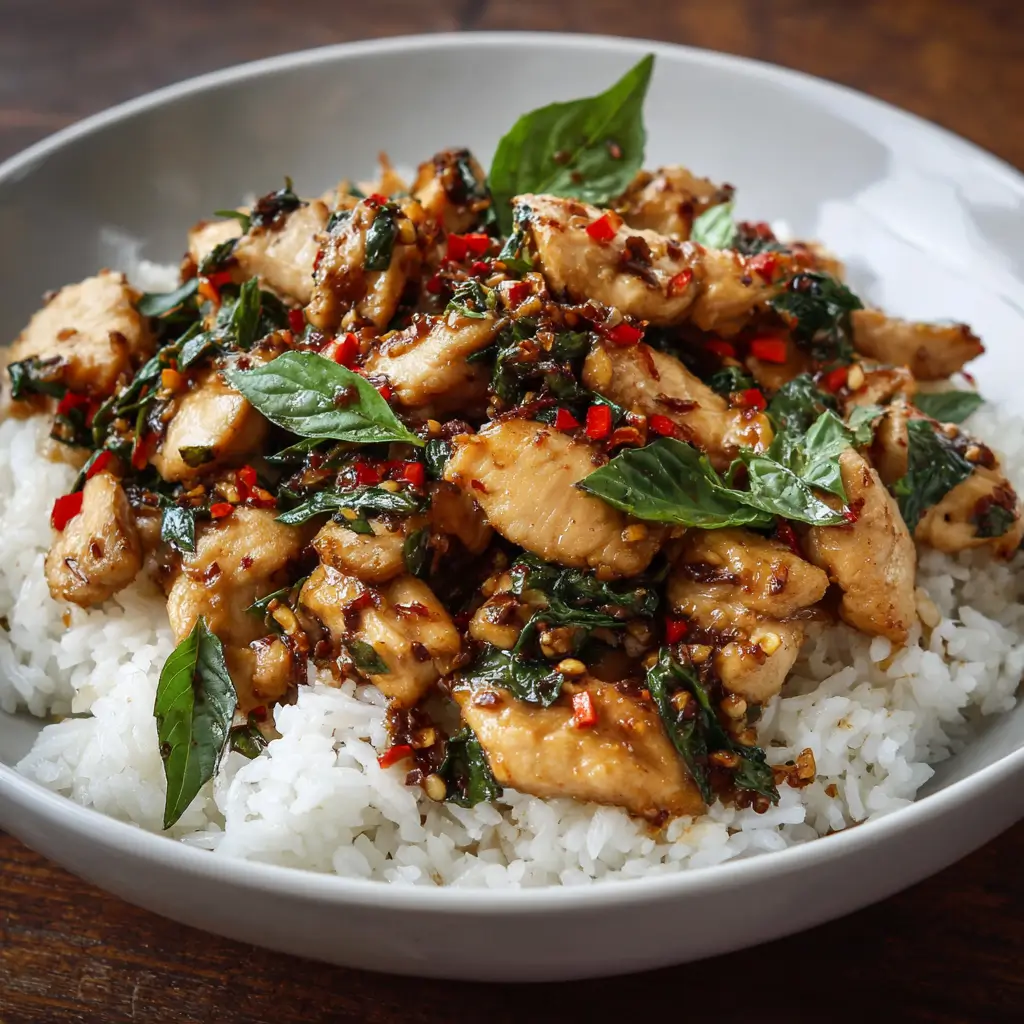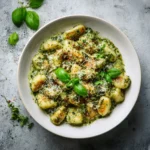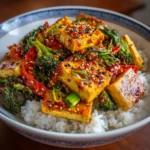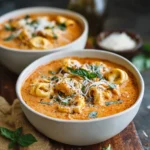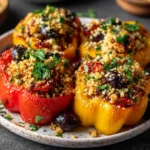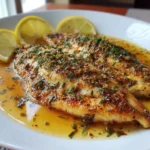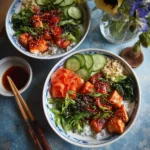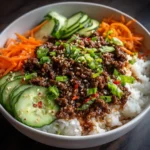Thai Basil Chicken: A Flavorful Stir-Fry Classic
Thai Basil Chicken, known in Thai as Pad Krapow Gai, is one of the most beloved dishes in Thailand and has gained immense popularity across the globe. This sizzling stir-fry combines tender chicken with aromatic Thai basil, garlic, chilies, and a savory-sweet sauce that dances on the palate. Served hot over steaming jasmine rice and often topped with a fried egg, it’s a satisfying meal that brings together bold flavors, vibrant colors, and comforting textures. Whether you’re a seasoned cook or trying Thai cuisine for the first time, this dish offers an accessible yet deeply authentic taste of Southeast Asia.
The History of Thai Basil Chicken
Thai Basil Chicken traces its roots to central Thailand, where street food culture thrives and quick, flavorful meals are part of everyday life. The dish evolved from traditional Thai cooking principles that emphasize balance—spicy, salty, sweet, sour, and umami—all harmonized in a single bite. While its exact origin remains undocumented, Pad Krapow (the general name for “stir-fried holy basil”) likely emerged in the early 20th century as urbanization increased demand for fast, affordable meals.
Originally made with pork or chicken, the dish became especially popular among laborers and office workers due to its energizing heat and rich flavor profile. Vendors would cook it fresh on high-powered woks, creating a smoky aroma that attracted customers from blocks away. Over time, variations appeared across regions: some added oyster sauce for depth, others used bird’s eye chilies for extra fire. Today, Thai Basil Chicken is not only a staple at roadside stalls but also a common home-cooked meal, reflecting both simplicity and sophistication in Thai culinary tradition.
Ingredients Breakdown: What Makes It Sing?
The magic of Thai Basil Chicken lies in its ingredients—each playing a vital role in building layers of flavor, aroma, and texture. Here’s a detailed breakdown:
- Chicken: Traditionally minced or thinly sliced chicken thigh meat is used for its juiciness and ability to absorb flavors. Breast can be substituted but may dry out if overcooked.
- Thai Basil (Holy Basil – Krapow): Not to be confused with sweet Italian basil, holy basil (Ocimum tenuiflorum) has a peppery, clove-like aroma and slight spiciness essential to authenticity. If unavailable, a mix of sweet basil and mint can mimic some characteristics, though the result won’t be identical.
- Garlic: Freshly minced garlic forms the aromatic base, releasing a pungent fragrance when seared in oil.
- Bird’s Eye Chilies (Prik Kee Noo): These tiny red or green chilies pack intense heat and are crucial for achieving the signature fiery kick. Adjust quantity based on spice tolerance.
- Fish Sauce (Nam Pla): A cornerstone of Thai seasoning, fish sauce provides saltiness and umami depth without tasting “fishy” when cooked properly.
- Oyster Sauce: Adds sweetness, richness, and body to the sauce while enhancing color and mouthfeel.
- Soy Sauces: Light soy sauce contributes saltiness; dark soy adds color and subtle caramel notes.
- Sugar (Palm or Brown): Balances the salty and spicy elements, rounding out the overall flavor.
- Cooking Oil: High smoke-point oils like vegetable or peanut oil work best for high-heat stir-frying.
- Jasmine Rice: The ideal companion—fragrant, slightly sticky, and neutral enough to let the bold stir-fry shine.
- Fried Egg (Optional but Traditional): A runny-yolk fried egg placed on top adds creaminess and completes the classic presentation.
Step-by-Step Recipe: How to Make Authentic Thai Basil Chicken at Home
Follow these steps carefully to achieve restaurant-quality results in your kitchen. Timing is key—this dish cooks quickly!
- Prepare Ingredients: Mince 2–3 cloves of garlic and slice 2–4 bird’s eye chilies (adjust to taste). Cut 1 lb (450g) of boneless chicken thigh into small cubes or use pre-minced chicken. Wash and dry a handful of fresh Thai basil leaves. Mix the sauce ahead: combine 2 tbsp fish sauce, 1 tbsp oyster sauce, 1 tsp soy sauce (light), ½ tsp dark soy sauce (for color), and 1 tsp palm sugar in a small bowl. Set aside.
- Heat the Wok: Place a wok or large skillet over high heat until very hot. Add 1–2 tbsp of cooking oil and swirl to coat the surface evenly. You want a shimmering, almost smoking pan for proper searing.
- Sauté Aromatics: Add the minced garlic and sliced chilies. Stir-fry for about 15–20 seconds until fragrant but not browned. Be careful—garlic burns easily.
- Cook the Chicken: Add the chicken pieces in a single layer if possible. Let them sear undisturbed for 30 seconds, then stir and continue cooking, breaking up any clumps. Cook for 3–4 minutes until fully done and lightly browned.
- Add the Sauce: Pour the prepared sauce mixture over the chicken. Stir well to coat every piece. Continue cooking for another 1–2 minutes to allow the flavors to meld and the sauce to reduce slightly.
- Incorporate the Basil: Toss in the fresh Thai basil leaves. Stir just until wilted—about 30 seconds. The leaves should remain bright green and release their signature aroma.
- Taste and Adjust: Give it a final taste. Need more salt? Add a splash of fish sauce. Too spicy? A pinch more sugar helps. Want depth? A dash of oyster sauce enhances richness.
- Serve Immediately: Spoon the hot stir-fry over a bed of freshly cooked jasmine rice. Top with a crispy-edged, runny-yolk fried egg if desired. Garnish with sliced red chilies or cucumber rounds for freshness.
Tips for Perfect Thai Basil Chicken Every Time
- Use High Heat: Authentic texture comes from rapid cooking at high temperatures, which locks in juices and creates a slight char (wok hei).
- Don’t Overcook the Basil: Add it last and cook only until wilted. Prolonged exposure to heat diminishes its unique flavor.
- Prep Everything Beforehand: Stir-fries move fast. Have all ingredients chopped, measured, and within reach before heating the wok.
- Balance the Flavors: Taste as you go. The ideal plate should have a punch of heat, a touch of sweetness, and a salty backbone—all balanced by the herbal note of basil.
- Fresh Ingredients Matter: Avoid dried herbs or powdered garlic. Freshness defines this dish.
- Rest the Protein: If using whole cuts of chicken, marinate briefly (10–15 minutes) in a teaspoon of soy sauce and cornstarch to tenderize and help retain moisture.
- Avoid Crowding the Pan: Cook in batches if necessary. Overcrowding lowers the temperature and causes steaming instead of searing.
- Use the Right Rice: Jasmine rice isn’t just traditional—it’s aromatic and slightly sticky, making it perfect for soaking up sauce.
Variations and Customizations
One reason Thai Basil Chicken remains so popular is its versatility. Chefs and home cooks alike adapt it to suit dietary needs, regional tastes, and personal preferences:
- Protein Swaps: While chicken is standard, many versions use ground pork, beef, shrimp, tofu, or even squid. Each brings a different texture and flavor profile.
- Vegan/Vegetarian Version: Replace fish sauce with vegan fish sauce or soy sauce, omit oyster sauce (or use mushroom-based alternative), and substitute chicken with firm tofu, tempeh, or plant-based ground “meat.” Use holy basil or a blend of Thai sweet basil and mint.
- Spice Levels: Mild version: remove chili seeds or use fewer chilies. Extra hot: add more bird’s eye chilies or a few drops of chili oil at the end.
- Gluten-Free Option: Ensure soy sauces are gluten-free (tamari works well), and verify oyster sauce is GF-certified or replace with coconut aminos and molasses for similar flavor.
- Add Vegetables: Some modern takes include bell peppers, snap peas, mushrooms, or baby corn for added crunch and nutrition. Just sauté them briefly before adding the chicken.
- Dry Style vs. Saucy: Street vendors in Bangkok often make it drier with minimal sauce clinging to the meat. For a saucier version, increase sauce ingredients slightly and serve with extra rice.
- Egg Variations: Instead of topping with a fried egg, try poached, soft-boiled, or even scrambled mixed into the dish.
- Regional Twists: In Northern Thailand, they might use fermented soybean paste; in Southern areas, turmeric or kaffir lime leaves could appear. Some fusion recipes add pineapple for sweetness or cashews for crunch.
Health Considerations and Nutritional Value
When prepared mindfully, Thai Basil Chicken can be a nutritious and well-balanced meal. Let’s break down its health aspects:
Nutritional Highlights (Per Serving, Approximate – Serves 2–3)
- Calories: ~350–450 kcal (depending on oil, portion size, and additions)
- Protein: ~25–30g (excellent source from chicken)
- Fat: ~15–20g (mostly unsaturated, depending on oil used)
- Carbohydrates: ~30–40g (primarily from rice and sugar in sauce)
- Sodium: ~900–1300mg (mainly from fish and soy sauces—can be reduced)
- Vitamins & Minerals: Rich in B6 and B12 (chicken), iron, zinc, and antioxidants from chilies and garlic.
Health Benefits
- High-Quality Protein: Supports muscle maintenance and satiety.
- Basil (Holy Basil): Contains eugenol and other compounds studied for anti-inflammatory, antimicrobial, and stress-reducing properties.
- Chili Peppers: Capsaicin may boost metabolism, aid digestion, and provide pain relief.
- Garlic: Known for immune-boosting and cardiovascular benefits.
- Low in Added Sugars (when controlled): Natural palm sugar has a lower glycemic index than refined white sugar.
Considerations & Modifications for Healthier Versions
- Reduce Sodium: Use low-sodium fish sauce, reduce overall用量, or dilute with water or lime juice. Taste gradually.
- Lower Fat: Use less oil or opt for healthier fats like avocado or sesame oil in moderation.
- Control Sugar: Minimize added sugar or skip entirely if the natural sweetness of oyster sauce suffices.
- Boost Fiber: Serve with brown jasmine rice or cauliflower rice. Add non-starchy vegetables like broccoli, zucchini, or bok choy.
- Balanced Meal: Pair with a side salad or cucumber relish to cool the heat and increase nutrient diversity.
- Portion Awareness: While delicious, the dish can become calorie-dense with excessive oil, sauce, or fried eggs. Stick to recommended serving sizes.
Ingredients
Serves 2–3
- 1 lb (450g) boneless chicken thighs, finely chopped or ground
- 3–4 cloves garlic, minced
- 2–4 Thai bird’s eye chilies, sliced (adjust to spice preference)
- 1 cup fresh Thai holy basil leaves (or substitute with sweet basil + a few mint leaves)
- 2 tbsp fish sauce (preferably premium Thai brand)
- 1 tbsp oyster sauce
- 1 tsp light soy sauce
- ½ tsp dark soy sauce (for color)
- 1 tsp palm sugar (or brown sugar)
- 1–2 tbsp vegetable or peanut oil
- 2–3 cups cooked jasmine rice (for serving)
- Optional: 2 eggs (for frying on top)
- Garnish: Sliced chilies, cucumber, or cilantro
Directions
- Mix together fish sauce, oyster sauce, light soy sauce, dark soy sauce, and palm sugar in a small bowl. Set aside.
- Heat a wok or large skillet over high heat. Add oil and swirl to coat.
- Add minced garlic and sliced chilies. Stir-fry for 15–20 seconds until fragrant.
- Add chicken and stir continuously, breaking it apart, until cooked through and lightly browned (3–4 minutes).
- Pour in the sauce mixture. Stir well and cook for 1–2 minutes until sauce reduces slightly and coats the chicken.
- Add Thai basil leaves and stir just until wilted (about 30 seconds).
- Meanwhile, prepare jasmine rice if not already done.
- Optional: Fry eggs sunny-side up or over-easy in a separate pan.
- Serve immediately over rice, topped with fried egg and garnished with chilies or cucumber.
FAQ (Frequently Asked Questions)
Q: Can I use regular basil instead of Thai holy basil?
A: You can, but the flavor will differ significantly. Sweet basil lacks the peppery, clove-like heat of holy basil. A workaround is to mix sweet basil with a few sprigs of mint or a pinch of crushed cloves for approximation.
Q: Is Thai Basil Chicken spicy?
A: Traditionally yes—it features bird’s eye chilies, which are quite hot. However, you can control the spice level by reducing the number of chilies or removing their seeds.
Q: Can I make it ahead of time?
A: Best served fresh. The basil loses its vibrancy when reheated, and the chicken may dry out. However, you can prep the sauce and chop ingredients in advance for quick assembly.
Q: Why does my dish taste too salty?
A: Likely due to overuse of fish or soy sauces. Always start with less, taste, and adjust. Adding a bit more sugar or a squeeze of lime juice can help balance excess saltiness.
Q: What kind of rice should I use?
A: Jasmine rice is traditional and pairs perfectly. Alternatives include brown jasmine rice, sticky rice, or even cauliflower rice for low-carb diets.
Q: Can I freeze leftovers?
A: Not recommended. The texture of the chicken and rice deteriorates upon freezing and reheating. Basil also doesn’t hold up well. Consume within 1–2 days refrigerated.
Q: What’s the difference between Thai basil and holy basil?
A: Holy basil (Kaphrao) is sturdier, spicier, and more medicinal-tasting. Thai sweet basil (Holy basil is often mislabeled in Western stores. True holy basil is harder to find outside Asia.
Q: Can I cook this in a regular frying pan?
A: Yes! While a wok gives better heat distribution, a heavy-bottomed skillet works fine. Just ensure it gets very hot before adding ingredients.
Summary
Thai Basil Chicken is a vibrant, aromatic stir-fry that captures the essence of Thai street food—bold, balanced, and deeply satisfying. With tender chicken, fiery chilies, fragrant holy basil, and a savory-sweet sauce, it’s a quick weeknight dinner that feels like a celebration.
